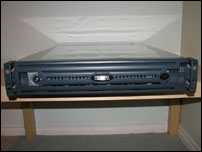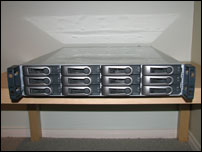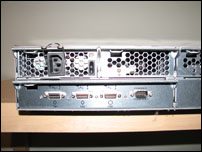Promise VTrak J300s
by Jason Clark & Dave Muysson on February 2, 2007 8:00 AM EST- Posted in
- IT Computing
The Promise VTrak J300s
Promise has long been known for their involvement in the storage industry. If you can remember back to the early nineties (Ed: sorry if that makes some of you feel old...), Promise was making VESA EIDE accelerator cards. Maybe unknown to some are their VTrak products targeted at the small to enterprise storage consumer. They have iSCSI SAN solutions and a range of Direct Attached solutions like the VTrak J300s that we're evaluating in this article.
The VTrak J300s is a 2U 12 drive RAID/JBOD solution capable of housing either SAS or SATA drives. It has the ability to daisy chain up to three additional chassis off the expansion port on the rear of the device. This would give you a total capacity of 24 TB when using 500GB SATA drives.
Each chassis has three 3 Gbit SAS 4x ports, two host ports and one expansion port for cascading the chassis together. If you're wondering what 4x ports are, it is another way to describe a wide port. As we discussed earlier in the article a wide port is made up over several links, in this case 4 links each with 3Gbit of bandwidth, which means that the 4x (wide port) is capable of 12 Gbit/sec of overall bandwidth.
Users can purchase an additional I/O module for redundancy, which also has three 3 Gbit 4x ports. Promise took reliability quite seriously with this unit; with redundant I/O, power, cooling, and monitoring there is no single point of failure. At the rear of the unit there is also a serial port that allows the administrator to use the Command Line Interface (CLI) and monitor the device remotely.
Management of the J300s was fairly simple and straightforward. The chassis and drives were identified by the RAID controller without any issue, including the Windows driver for the chassis. The CLI gives you access to a number of things such as fan speeds, voltages, temperature, SAS addresses, phy status, error counters, etc. It also lists vital product data for field replaceable units, current firmware version, uptime, and thermal management control. We found the CLI to be easy to navigate, and complete documentation is provided on its use.
Promise has long been known for their involvement in the storage industry. If you can remember back to the early nineties (Ed: sorry if that makes some of you feel old...), Promise was making VESA EIDE accelerator cards. Maybe unknown to some are their VTrak products targeted at the small to enterprise storage consumer. They have iSCSI SAN solutions and a range of Direct Attached solutions like the VTrak J300s that we're evaluating in this article.
 |
 |
| Click to enlarge | |
The VTrak J300s is a 2U 12 drive RAID/JBOD solution capable of housing either SAS or SATA drives. It has the ability to daisy chain up to three additional chassis off the expansion port on the rear of the device. This would give you a total capacity of 24 TB when using 500GB SATA drives.
 |
 |
| Click to enlarge | |
Each chassis has three 3 Gbit SAS 4x ports, two host ports and one expansion port for cascading the chassis together. If you're wondering what 4x ports are, it is another way to describe a wide port. As we discussed earlier in the article a wide port is made up over several links, in this case 4 links each with 3Gbit of bandwidth, which means that the 4x (wide port) is capable of 12 Gbit/sec of overall bandwidth.
Users can purchase an additional I/O module for redundancy, which also has three 3 Gbit 4x ports. Promise took reliability quite seriously with this unit; with redundant I/O, power, cooling, and monitoring there is no single point of failure. At the rear of the unit there is also a serial port that allows the administrator to use the Command Line Interface (CLI) and monitor the device remotely.
Management of the J300s was fairly simple and straightforward. The chassis and drives were identified by the RAID controller without any issue, including the Windows driver for the chassis. The CLI gives you access to a number of things such as fan speeds, voltages, temperature, SAS addresses, phy status, error counters, etc. It also lists vital product data for field replaceable units, current firmware version, uptime, and thermal management control. We found the CLI to be easy to navigate, and complete documentation is provided on its use.










31 Comments
View All Comments
yyrkoon - Friday, February 2, 2007 - link
When are you guys going to do some reviews on consumer grade equipment ? Well, let me clarify, 'consumer grade' with on card RAID processor(s). For instance,, right now, I'm in the market for a 8 + port RAID HBA, but would like to know if buying a Highpoint 16 port SATA RAID HBA, would really be any worse than getting an Areca 8 port HBA, for ~$200 usd more. 3Ware, from what I understand offers the best Linux/Unix support, or does it ? If so, would it really make much of a difference in a SOHO application ?I personally, would like to see a comparison of the latest Promise, Highpoint, Areca, 3Ware, etc controllers. In short, there is a lot out there for a potential buyer, such as myself, to get lost in, and basically, I personally am interested in reliability first, speed second (to a point).
Anyhow, I just thought I'd point out, that while you guys do cover a lot in the area, you guys seem to have a gap, where I think it really matters most to your readers (home PC / enthusiast crowd/SOHO).
mino - Saturday, February 3, 2007 - link
I would stay away from Highpoint.We have had several issues of RAID HBA(new one!) consistently going down AND screwing the whole RAID5 ubner some workloads. For the money one is better off with QuadFX ASUS board than to go Highpoint-like solutions.
Areca is pretty much on a different level, ofcourse...
yyrkoon - Sunday, February 4, 2007 - link
Again, this only reinforces what I've said, need a good article on which HBAs are good for reliability, etc.mino - Sunday, February 4, 2007 - link
Any 3Ware, Areca, LSi, Adaptec solution should be just fine.Most people do not actually need RAID5 for home usage and it is usually cheaper to go _software_ RAID1 with every drive in the RAID attached to different controller. In such a scenario even the cheapest or onboard controller offers comparable fault-tollerancy to high-end RAID% solutions.
However the simplest way to go is really 2 NAS RAID5 boxes mirroring each other.
dropadrop - Tuesday, February 6, 2007 - link
I would rule out Adaptec and the older LSI chipsets still available (under several brands like Intel for example). We replaced a bunch of Intel 6 & 8 port controllers with top of the line 8-port Adaptec SATA II controllers.
The performance of the Intel controllers (with LSI chipsets) was terrible. We got about 8-13MB/s sequential writes with RAID 10 arrays, and tested using alot of differant drives. The Adaptec products are alot better in regard to speed, but keep dropping drives. This seems to be a common problem, but they have no solution.
I've previously used 3ware without any problems, and would gladly test Areca if they where available here.
yyrkoon - Sunday, February 4, 2007 - link
why would I want to spend 1300 usd + per 5 disk array (minus drives), when I could build my own system much cheaper, and use the hardware/software I wanted ? Just because I don't know which HBAs are more reliable, than others (because I obviously cant afford to buy them all), doesn't mean I'm an idiot ;)Bob Markinson - Friday, February 2, 2007 - link
Interesting review!I would have liked to see a comparison with latest gen 15K SCSI drives and not 10K SCSI drives to see the true SAS interface performance advantage over SCSI. Futhermore, the Serveraid 6M comes in two versions - one with 128 MB cache and the other with 256 MB cache. Also, there were performance issues with early 7.xx firmware/sw revisions on the 6M at high IO loads - hopefully you ran the tests most recent firmware. Write-back cache was enabled on the 6M, right?
Lifted - Tuesday, February 6, 2007 - link
Based on the title of the article, Promise VTrak J300S, you are expecting too much. The "comparison" was more like an ad for the product. What is point in comparing 10K U320 vs 15k SAS? It's supposed to tell us what exactly? You clearly need to look elsewhere for a SAS vs U320 comparison if that's what you were expecting here. This was more for kicks I think, and perhaps to make the J300S look better than ____ ??? I don't get it, it's just a storage enclosure. The RAID adapters and drives are what determine performance, so why was this apples-to-oranges "performance" review thrown into an enclosure article?Odd, quite odd.
fjeske - Friday, February 2, 2007 - link
Isn't it a bit unfair to use old IBM 10K SCSI drives in this comparison? None of the now Hitachi drives show good performance on Storagereview.com. Compare to Seagate's Cheetah 15K.5 and I think you'll see a difference.Also, how was the SCSI setup done? Attaching 12 drives to one U320 bus will obviously saturate it. Servers usually pair them when connecting this many drives.
cgaspar - Friday, February 2, 2007 - link
SAS and SCSI drives have disk write caches disabled by default, as the drives' caches are not battery backed. IDE and SATA drives frequently have write caching enabled by default. This makes writes much faster, but if you loose power, those writes the drive claimed were committed will be lost, which can be a very bad thing for a database. I'd suggest disabling the write cache on the SATA drives and re-testing (if you still have the gear), I suspect the results will be illuminating.